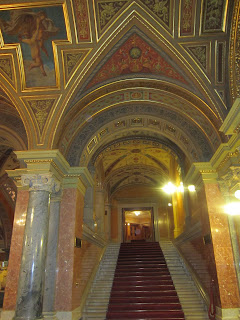On April 26, all of the Senior couples and sisters got together to tour the Jewish Synogogue in Budapest, the largest one in Europe.
It was a beautiful building inside and out. It was severely damaged during World war II when Germany occupied Hungary. Later when they got their country back, they received millions of dollars from the State and wealthy people in America. After listening to a very nice Hungarian lady give the history of the synagogue in English (it was very hard to understand) we went to the Jewish Cemetery right there beside the synagogue.

According to Jewish traditions cemeteries can’t be on the premises of the synagogue, but during World war II, it was part of the Jewish Ghetto and served as a shelter for a lot of people. Over two thousand of them died from hunger and cold that year and were buried in the courtyard of the synagogue. It was a very sad story. They also had a memorial to Raoul Wallenburg, a Swedish architect who helped to save up to 100,000 Jews by issuing them passports and sheltering them in buildings designated as Swedish territory. However, he ended up getting caught and dying in a Nazi prison.
Part of the memorial was a huge metal weeping willow tree with metal leaves containing 400,000 names of Hungarian Jews murdered by the Nazi’s. They had a very nice museum that told more sad stories. I don’t think I can handle going to the House of Terrors.
After our tour, we went to lunch at another new restaurant and then everyone went home. It was nice to get together with all of the other Senior Couples.
Memento Park
On Tuesday, May 1st, we went to Memento Park for our Super PDay. This is where the Hungarians moved many of the communist statues and monuments following the fall of communism in Hungary.
One of my favorite statues used to be part of the liberation monument at the top of Gellért Hill. But, because Russia went from being liberator to oppressor, it was knocked down during the 1956 revolution. They replaced it with an exact copy, but it wasn’t left on Gellért Hill. It was moved to Memento park. It is an amazing work of art and huge (23 ft high)!
Another one I really liked was another humongous one. It is a giant charging sailor that was based on a 1919 revolutionary poster.
Another one I thought was cool looking was the Béla Kun Memorial. In it, Béla Kun is seen leading the assault, while waving goodbye with his hat. His ship is being tossed about in a storm. The crowds of people, whose feet are not touching the ground, are coming from nowhere and heading nowhere symbolizing those who were executed during the Red Terror period. This monument was created to mock Béla Kun as a leader, but, it’s a cool looking memorial. :)
The monument to Hungarian-Soviet Friendship was a very nice one as well. At the base of the statue it says, “Szabadságunk és belénk záloga a Magyar-szovjet órok baratsag” which means “The token of freedom and peace is the Hungarian-Soviet eternal friendship.” It’s kind of a sad phrase considering how it ended up. The Soviet’s drove the German forces out of Hungary, which to the Hungarians meant freedom from the danger of holocaust and the end of the war. But, that was not to be. They went from one dictatorship to another.




















